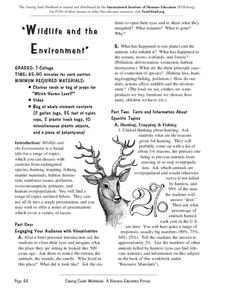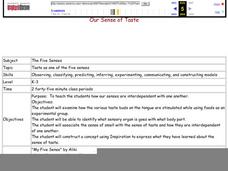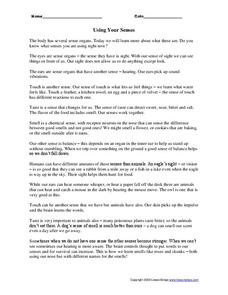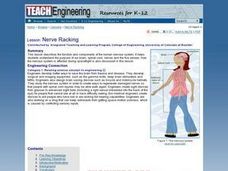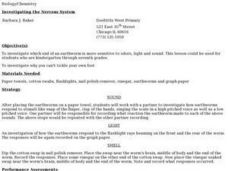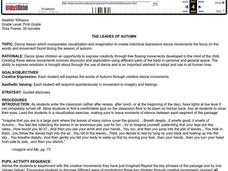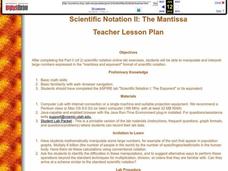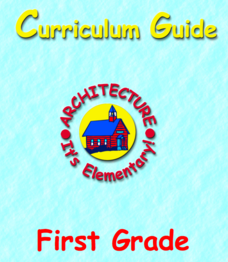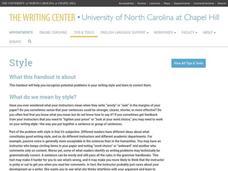Curated OER
Environmental Education
In this environment learning exercise, middle schoolers read about the numerous activities and then take part in participating in one as a teacher or student led project.
Curated OER
Scientific Notation II: The Mantissa
Students after completing the Part II (of 2) scientific notation online lab exercises, manipulate and interpret large numbers expressed in the "mantissa and exponent" format of scientific notation.
Curated OER
Our Sense of Taste
Students explore the relationship between the senses of taste and smell using a blindfold taste test. In partners, they taste different foods with their noses plugged and unplugged. They create a life size outline of the human body to...
Curated OER
Using Your Senses
In this using your senses worksheet, students read a 1 page article on senses and then connect 6 body parts to their actual senses by drawing a line from one to the other.
Curated OER
Nerve Racking
Fifth graders study the components and function of the nervous system. They investigate how engineers design biomedical equipment to assist the nervous system and explain how the five senses are affected during spaceflight.
Curated OER
Simple and Complete Subjects
In this grammar practice worksheet, students respond to 5 fill in the blank and 13 short answer questions that require them to identify simple and complete subjects and predicates.
Curated OER
Earthworm Nervous System
Investigate the nervous system of an earthworm! Your class gets into pairs to test, record, and draw conclusions about the reaction earthworms have to different stimuli (sound, light, and smell).
Curated OER
THE LEAVES OF AUTUMN
Dance gives children an opportunity to express creativity through free flowing movements developed in the mind of the child. Creating these dance movements involves discovery and exploration using different parts of the body in personal...
Curated OER
Westward Expansion
Students examine how the events that took place during the time of the Westward Expansion affected the pioneers and Native Americans through the seven lessons of this unit. Enhancements in transportation over time are also a part of the...
Curated OER
What Kind of Insect is That?
Fifth graders characterize insects and classify insects according to the Linnaean system. They use hand lenses or microscopes to examine insect body parts.
Curated OER
Sorting
Students explore how to sort and manage information. In this organization lesson plan students complete an activity on sorting.
Curated OER
Religious Crusades
In this religious Crusades worksheet, students respond to 2 questions that require them to write paragraphs about the effects of the Crusades. Students also examine a map of the wars and respond to short answer questions.
Curated OER
Create Your Own Ad
Students examine the elements of advertising. They analyze the format and structure of advertisements. They develop awareness of advertising techniques and explain that media messages and products are composed of a series of separate...
Curated OER
Stars and The Modern Telescope
In this stars and the modern telescope worksheet, students use a photograph taken by the 2MASS telescope to calculate the number of bright stars and faint stars in the picture, the size of the picture, and the number of stars expected to...
Curated OER
The Golden Ratio
Seventh graders investigate a ratio found in nature and in numerous pieces of artwork throughout history. The lesson is cross-curricular and builds a sense of appreciation of design for students.
Indiana University
World Literature: "One Evening in the Rainy Season" Shi Zhecun
Did you know that modern Chinese literature “grew from the psychoanalytical theory of Sigmund Freud”? Designed for a world literature class, seniors are introduced to “One Evening in the Rainy Season,” Shi Zhecun’s stream of...
National Park Service
A Natural Resource Called Peace
Get your pupils outside and teach them about peace at the same time! Scholars create a list describing peace, hike outside, add to that list, and later create poems. The exercises support differentiation for your individual classes as...
Curated OER
EEEK! A Spider!
Youngsters complete a unit of lessons based on the story "Little Miss Muffet." They predict what will happen in the story, and use context clues to look for meaning in the words. They research information about spiders using the Internet...
Curated OER
Credible Sources on the Internet: What to Trust, What to Dismiss and When to Cite a Source
Wait, you mean researchers don't all use Wikipedia? Teach your class about intelligent research with a lesson about evaluating digital sources. The lesson starts with a quickwrite and includes vocabulary exercises and several...
Curated OER
Scientific Notation II: The Mantissa
Practice converting a conventional number into scientific notation, and vice-versa. Using an applet, they perform the operations of multiplication and division on numbers expressed in scientific notation.
American Institute of Architects
Architecture: It's Elementary!—First Grade
Build an interest and appreciation for architecture in your young learners with this fun 10-lesson art unit. Engaging children in using their five senses, the class first observes the environment around them, paying...
Centers for Disease Control and Prevention
Understanding the Epidemiologic Triangle through Infectious Disease
Introduce infectious diseases and the epidemiologic triangle. A helpful resource describes the agent, host, and environment from the three vertices as well as the time factor, which is in the middle. Scholars complete a simple...
University of North Carolina
Style
Just like you choose your clothes to ensure they fit the occasion, you should choose your words deliberately while writing. Style, the main topic of one handout in a series on writing skills, involves choosing words carefully and paying...
Biology Junction
Mollusks
Mollusks created every shell on Earth. Young scientists learn more about the phyllum mollusca in an informative presentation. It covers their characteristics, body plans, and relationships in the ecosystem. Then, it details each class of...
